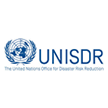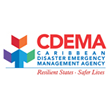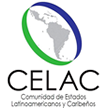- La UE y LAC, juntas en desastres naturales y humanitarios
- México, el país más vulnerable a desastres naturales de América Latina
- América Latina y el Caribe firman con la UE Un MdE sobre Cooperación en materia de Gestión Integral del Riesgo de Desastres
- El mundo está en la autopista hacia el infierno climático
- Informe de la Unesco advierte sobre el calentamiento global acelerado y el aumento del nivel del mar
Staffers were still counting when UN Secretary-General Ban Ki-moon announced that more than 1,500 commitments had emerged from the bewildering series of closed-door roundtables, panel discussions and impromptu announcements that constituted World Humanitarian Summit.
Navigating the labyrinth of back corridors crammed with aides and security people was in and of itself a challenge, let alone making sense of the outcomes of thousands of people simultaneously discussing a range of issues in some 200 separate events. As one observer put it: “Part high-level political meeting, part public caucus, the meeting itself was schizophrenic by design.”
As the dust settles, here’s our summary of what was – and wasn’t – agreed. (Tweet us to fill in any gaps: @irinnews)
And a reminder: Here’s what was on the table for discussion in the lead-up.
What was agreed
Aid financing must be more efficient: The most concrete outcome of the summit was the top 30 donors and aid agencies signing a so-called “Grand Bargain” to make aid more efficient, including harmonising time-consuming donor proposals and reporting, reducing overhead costs, introducing collective needs assessments, and earmarking less funding to specific projects (See: Is the Grand Bargain a Big Deal?). A shift towards greater use of cash transfers as aid was generally endorsed, but specific targets were limited to individual pledges rather than collective agreement, and more so among NGOs than governments (though the UK and Italy were notable exceptions). For example, World Vision and the International Rescue Committee pledged that half and one quarter of their programming, respectively, would be in the form of cash by 2020, well above the current sector average of six percent. Some donors also began announcing multi-year humanitarian grants for the first time, and agreed to raise the ceiling of the Central Emergency Response Fund, which allows UN agencies to respond faster and more flexibly, from $500 million to $1 billion. Moving forward, the institutional responsibility for the Grand Bargain still needs to be settled, with the Organisation for Economic Co-operation and Development and the Inter-Agency Standing Committee as possible convenors.
Aid must be locally-driven: As expected, “localisation” came out a winner in the discussions, with a target agreed in the Grand Bargain to direct 25 percent of humanitarian funding “as directly as possible” to local and national agencies. The summit also saw the long-awaited launch of NEAR, a network aiming to “reshape the top-down humanitarian and development system to one that is locally driven and owned, and is built around equitable, dignified and accountable partnerships”. Twenty-seven international NGOs also signed the new Charter4Change, committing to passing 20 percent of their funding to national NGOs by 2018 (and publishing that percentage transparently) as well as addressing the negative impact of recruiting local staff into international NGOs, thus draining local organisations of their capacity.
Education is a humanitarian priority: One former Save the Children staffer said she almost cried at the launch of the Education Cannot Wait fund, a recognition – after years of lobbying – that education is just as important as food and shelter in a crisis. “This is new,” Peter Maurer, president of the International Committee of the Red Cross, told IRIN, “and we shouldn’t underestimate when such consensus-building happens in conferences.” On average, less than two percent of humanitarian aid goes towards education (some donors pledged to individually raise that to 30 percent). The fund aims to raise $3.85 billion over five years, and already has $90 million in contributions from Dubai Cares, the European Union, the Netherlands, Norway, the UK, and the United States.
Humanitarian response must better include people with disabilities: Nearly 100 governments, aid agencies and others signed on to another Charter, this one committing not to discriminate against people with disabilities in humanitarian action, to better meet their needs, and to include them in the design of aid programmes.
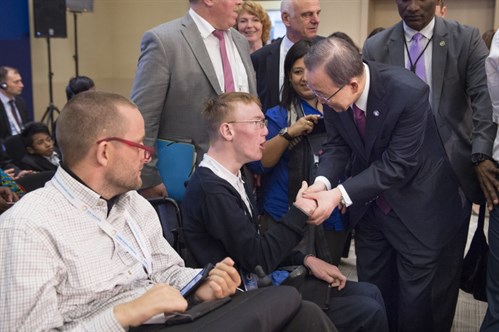 UN Photo/Eskinder Debebe
UN Photo/Eskinder DebebeThe world must invest in prevention and risk mitigation: It is a long-established factoid that investing $1 in preparing for crises will save you $7 responding to them, and yet it has proven very difficult to make that shift. The UN’s disaster risk reduction body had called for a “marker” to track DRR spending, though no specific target was set. A (bigger) conference in Sendai last March tackled this subject, but how prevention and cure can be combined (and where “resilience” fits in) nudged forward in the World Humanitarian Summit process. Several new initiatives reflect a greater consensus around the need to shift focus. The finance ministers of the Vulnerable 20 Group launched, alongside the World Bank and the UN, a new partnership to help their countries better prepare for shocks, including better access to risk analysis, contingency plans and social protection schemes. The International Federation of the Red Cross is leading a separate coalition to mobilise one billion people to be “resilient” by 2020. Another alliance, on urban crises, includes a focus on preparing for crises in urban settings, particularly with local municipal actors. Ban said the UN would focus on improving its risk analysis and Liberia announced a regional early warning system for West Africa.
Innovative financing mechanisms must be tested: Facing a funding gap very roughly estimated at $15 billion in responding to crises, the summit emphasised the need for innovative approaches to financing. Several initiatives were announced, including a humanitarian impact bond, in which private investors make an initial investment into a humanitarian response programme and are reimbursed (with a profit) by traditional donors only if certain outputs are met; an autonomous, global Islamic endowment fund for humanitarian needs; and a private-sector led initiative to increase risk financing in the most vulnerable countries (backed by a fund to help pay the premium). Hundreds of companies also signed up to a new initiative to better coordinate the private sector’s involvement in humanitarian action. While one financial analyst noted that some of the “vogue” financing innovations were not always rigourously sound in their economic theory, the summit reflected clear donor support for these kinds of initiatives.
Regional organisations have a role to play: Regional inter-governmental organisations have long complained that, despite being well-positioned to respond to crises in their regions faster and in a more culturally sensitive way, they do not have enough of a place at the humanitarian decision-making table. Recent years have seen efforts to build the capacity of groups like the Association of Southeast Asian Nations and the Arab League (often to limited effect), but this summit went further, giving birth to a Regional Organisations Humanitarian Action Network (ROHAN), which aims to formalise the role of regional organisations in the international humanitarian architecture. “Early days,” said Oliver Lacey-Hall, who heads the UN Office for Coordination of Humanitarian Affairs in Jakarta and has worked closely with ASEAN, but “my sense is that this represents increasing confidence that regional organisations (and their member states) have a role in humanitarian affairs.”
The humanitarian sector is an eco-system, not a system: In some ways, the summit’s structure was both its strength and its weakness. Unlike COP21 and most big UN summits, the WHS was not an inter-governmental process in which governments try to agree a specific text in advance. Rather, it sought a range of ideas from all actors involved in aid, including civil society organisations and the private sector. This meant it was unwieldy and unfocused. But it also meant that many voices that do not traditionally have power were heard. The fact that the summit took place in the chaotic and directionless way that it did was in itself a tacit recognition of a narrative that has become increasingly popular: the humanitarian sector is an “eco-system” rather than a top-down, command-and-control system, requiring a stronger shift to collaboration and “inter-operability” (yes, I used the term!) among all its actors. By bringing such a variety of actors to the table, the summit also helped put humanitarian issues higher on the agenda in the politics, business and society at large. One UN staffer called it a “coming of age” for the sector, and several participants noted a positive energy and real momentum in both the coming together of such a range of people as well as the ideas discussed.
The humanitarian sector must better respond to conflicts: The humanitarian sector’s best organisational set-up, financing and approaches – largely built in the aftermath of the 2004 Indian Ocean tsunami – are tailored for responding to natural disasters. But 80 percent of humanitarian response takes place against a backdrop of protracted conflict. And there, the system struggles. For Yves Daccord, director-general of the ICRC, the Syrian war and resulting refugee crisis have forced the realisation that protracted conflict must be at the core of humanitarian work – and this summit has crystallised that point. The WHS is “reinforcing and accelerating a pivot”, added Jeremy Konyndyk, director of the Office for US Foreign Disaster Assistance, “towards a system that is focused more on that and can address that in a more coherent and systemic way.”
What wasn’t agreed
All told, some 8,000 people attended the summit (including the exhibitors), representing 173 countries (including 55 heads of state), as well as representatives of UN agencies, NGOs, civil society organisations, philanthropy, the private sector and academia.
“Aligning such a constellation of actors is inherently challenging,” Ban told journalists at the close of the summit.
Here’s where they didn’t make much progress.
Political will to end conflicts: Perhaps the biggest disappointment of a summit aimed at finding ways to prevent and end conflicts was the absence of world leaders, particularly the five permanent members of the UN Security Council. Konyndyk defended US President Barack Obama’s no-show this way: “I don’t think there’s any questioning the US commitment to this issue… the president just wasn’t able to personally come to this summit.” But his and others’ absence made the high-level roundtable on “political leadership to end and prevent conflict” a bit hollow, despite some interesting pledges (France, for example, said it would not use its Security Council veto in cases of mass atrocity). “That it was ‘OK’ for them not to turn up at senior levels and to receive no blow-back other than a very gentle admonishment from the secretary-general reflects pretty poorly also on the state of power relations,” one UN official commented.
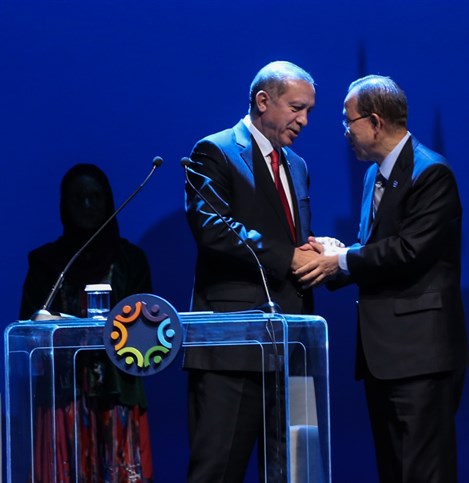 WHS/Metin Pala
WHS/Metin PalaA better deal for refugees, displaced people and their hosts: In the lead-up to the summit, the UN secretary-general had proposed a fairer approach to sharing the burden of refugees with host countries, and a target to reduce internal displacement by 50 percent by 2030. While migration was discussed in a refreshingly “sober way”, as Maurer of the ICRC put it, participants only “resolved to pursue a new approach” to address the needs of internally displaced persons and refugees, according to the official summary, without anything more concrete. Former UN high commissioner for refugees Antonio Guterres was vague when asked whether any real progress had been made, telling IRIN: “I think that there is a lot of progress being made in this regard but there is still a long way to go.” Jeff Crisp, a refugee analyst and former head of policy at the UN Refugee Agency, was more direct. Regarding forced displacement, he said, “both expectations and achievements of the WHS were very modest.” Diplomatic ammunition may be conserved for twin UN and US events on the subject of migration on the margins of the General Assembly on 19-20 September.
Protecting civilians in war: For Jan Egeland, special advisor to the UN Special Envoy for Syria, the test for success was whether the summit’s outcomes would change anything for civilians being bombed in Syria’s Aleppo city. “There is more [emerging from the summit] in the area where we are already fairly good, which is assistance,” Egeland told IRIN. “In protection, I have seen less, unfortunately, because it’s more difficult. And that was where I had hoped we would have focused more,” he said, echoing the views of several NGOs. Maurer was more nuanced, saying that while he couldn’t speak of “spectacular advances”, he did see a broader consensus that respecting the rules of war was important. Manuel Bessler, head of the Swiss government’s humanitarian aid unit, noted a lot of “rallying around the flag” during a session on respect for international humanitarian law, but “it was a bit ‘preaching to the converted’,” he told IRIN. “There were a lot of commitments, but commitments of those who are committed. We need commitments of those who are not, or not yet, or have to be convinced. On this front, we have to do more; do better.” That the summit even had to ask for commitments to uphold internationally agreed norms is a reflection of how far there is to go.
Bridging the humanitarian-development divide: One of the biggest focuses in the lead-up to the summit was breaking down the “silos” of humanitarian response, climate change mitigation, and development work, towards a more coherent approach to aid. The big UN agencies all signed on to a new “Commitment to Action” on collaborating in a “New Way of Working” (yes, with capitals) together towards collective outcomes consistent with the Sustainable Development Goals over multi-year timeframes. And yet the summit failed to crystallise what exactly that convergence means. As one UN staffer put it, “there is space for a joined-up approach, but why don’t you bloody-well define it?” The issue remains contentious, particularly for humanitarian “purists” who worry humanitarian action will become politicised if merged into development work. Germany led a heated debate in one session against the push for convergence, saying it would “make sustained funding to humanitarian organisations conditional on the inclusion of respect for humanitarian principles in internal policies and training as well as transparency on how humanitarian principles are upheld in practice."
Putting people at the center: For all the talk of putting people affected by crises “at the centre” of humanitarian action, the subject didn’t feature much at the summit, having largely been left out of the secretary-general’s report framing the summit’s priorities, despite being a big theme in the preceding consultations. In the main session designed to discuss it (which was tacked onto the agenda belatedly), “there was no mention of the word ‘accountability’,” said one of the session’s attendees. Organisers had hoped for a clearer way to allow the “end-users” of aid to have a real influence. These would include commitments to sign up to CHS Alliance standards, adopt a common approach to getting feedback from affected communities, and make funding conditional upon projects acting on feedback from affected communities (as the US and UK already do). The “participation revolution” got a nod in the Grand Bargain, but compared to other aspects of that agreement, was “very vague and very aspirational”, according to Kate Halff, executive secretary of Steering Committee for Humanitarian Response, which represents nine of the world’s leading aid agencies. Several governments and organisations pledged to adopt the CHS Alliance’s accountability standards and, Lise Grande, deputy special representative of the United Nations Assistance Mission for Iraq, made specific and well-received recommendations on how they can be applied in the field.But accountability advocates were generally disappointed by the priority given to the subject at the summit. As Oxfam put it in a release, “governments have continued to only pay lip service to accountability.”
UN reform: Like accountability to affected people, UN reform featured low-to-invisible in the secretary-general’s priorities, on which the summit agenda was created. “One of the biggest failures of the WHS process has been that we're not having this honest conversation around reform of the UN Security Council, the reform of the UN agencies, the political reform required,” said Degan Ali, co-founder of the NEAR network of southern NGOs. “I think that has been an abject failure of the World Humanitarian Summit, I am sorry to say, and I think there are established institutions that don't want to have these conversations.” The Grand Bargain went some way to address some of the structural reforms needed, for example by committing to coherent and “impartial” needs assessments and less competition between aid agencies. But while governments and NGOs have had hard looks at reform, according to James Munn, head of policy at the Norwegian Refugee Council, “I’m concerned that the UN agencies are the ones still holding back on making strong changes to the way they do business.” At a side-event, Nan Buzard, head of the NGO consortium ICVA, wondered if the rapid adoption of cash aid (which makes some UN agency specialisms moot) was a “back door” to UN agency and mandate reform.
A roadmap for what happens next: The unwieldy list of individual and collective commitments will be gathered into what the UN calls a “Commitments to Action platform” that will be publicly accessible “and allow us to hold ourselves to account for commitments made,” Ban said. Exactly how that will happen is not yet clear. The UN plans to “review” the commitments with the summit’s participants over the summer before Ban presents a report to the UN General Assembly in September with recommendations for member states. “I will propose ways on how to take commitments forward, including through intergovernmental and inter-agency avenues,” he said, possibly through the UN Economic and Social Council, ECOSOC. Ban promised an annual update that will review progress made in implementing the summit’s commitments. “The WHS must now lead to a robust framework of accountability and a roadmap for delivering on the commitments made by all actors that attended the Summit,” World Vision said. Many of those actors have admitted to not knowing exactly how they will implement some of the commitments they made.
As Bessler put it: “There are some questions with these commitments: ‘How do we do this now’?”
With additional reporting by Ben Parker and Andrew Gully.
- El Niño 2023-2024 América Latina y el Caribe
- Compendium of good practice on post disaster recovery in the Latin America and Caribbean Region: 12 Good practices
- Avances y desafíos de la cooperación internacional en desastres
- Informe de relatoría - Taller para la construcción de lineamientos estratégicos para la gestión del riesgo de desastre en América Latina y el Caribe
- Informe resumido, 17–19 de mayo de 2023: Reunión de alto nivel sobre la revisión intermedia del Marco de Sendai




